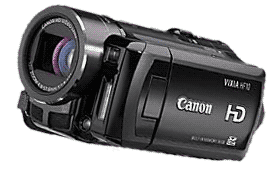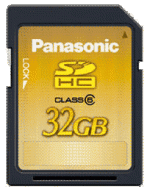 As an emerging video acquisition format, AVCHD holds the promise of offering stunning full HD images at the same data rate as DV. But thus far, all manufacturers of AVCHD cameras are using reduced bitrate settings to offer more recording time on flash media recorders.
As an emerging video acquisition format, AVCHD holds the promise of offering stunning full HD images at the same data rate as DV. But thus far, all manufacturers of AVCHD cameras are using reduced bitrate settings to offer more recording time on flash media recorders.
Will 2008 finally change all this?
.
When AVCHD was introduced, the specification looked very impressive. The goal was to use advanced MPEG-4 encoding and compressed audio to provide much better HD imagery than we were getting with HDV. AVCHD would also have a variable data rate which would enable users to choose between image quality and record time for each recording. This variable recording rate is what made SanDisk’s “Video” media with specific recording times listed on the label such an oxymoron.

Meanwhile, HDV uses the same data rate and tapes as DV, allowing production houses to buy one camcorder but use it in two completely different modes—SD and HD. That means great bang for the buck, and fewer production workflow changes for DV shooters making the transition to HDV as their HD-resolution medium of choice.
 AVCHD was limited to consumer camcorders in 2007—tiny handhelds that were far from professional because they lacked immediate access to almost all the features we associate with professional production because there was simply no room for buttons or professional audio jacks on the bodies of these diminutive camcorders.
AVCHD was limited to consumer camcorders in 2007—tiny handhelds that were far from professional because they lacked immediate access to almost all the features we associate with professional production because there was simply no room for buttons or professional audio jacks on the bodies of these diminutive camcorders.
When you need to turn down the audio during a wedding because something suddenly became far louder than you expected, you don’t have time to use a single joystick or scroll wheel to navigate through numerous menus to get to the audio, go to the level adjust, adjust the level down … It’s much better to flip a switch, and bam, it’s padded.  Plus you avoid the visible camera shake that happens when you click and scroll through all the menus.
Plus you avoid the visible camera shake that happens when you click and scroll through all the menus.
Panasonic is due to change this with the release of their AG-HMC70, which I had my hands on at Government Video Expo in Washington, D.C. in December and profiled with an in-depth “walk around” video on my blog.
The HMC70 takes the HSC1U (which is Panasonic’s consumer HDC-SD1 with few alterations) and allows users to put the camcorder on their shoulders. The HMC70 takes a larger battery pack for all-day use; it has plenty of space to attach accessories, two big XLR jacks, a viewfinder, and an LCD, as well as plenty of buttons and knobs to easily access the features we need the most.
 What Panasonic didn’t do, aside from adding a second SD slot, was to increase the data rate from the HSC1U’s artificially limited data rate of just 13Mbps. It also records at 9 and 6Mbps. But since numerous reviewers have agreed that 13 and 15Mbps AVCHD footage isn’t quite up to the standard of HDV, 9 and 6Mbps are clearly too low for professional use.
What Panasonic didn’t do, aside from adding a second SD slot, was to increase the data rate from the HSC1U’s artificially limited data rate of just 13Mbps. It also records at 9 and 6Mbps. But since numerous reviewers have agreed that 13 and 15Mbps AVCHD footage isn’t quite up to the standard of HDV, 9 and 6Mbps are clearly too low for professional use.
AVCHD may be touted as twice as efficient as HDV. Thus far, even those camcorders that can record at 13 and 15Mbps (more than half of the HDV data rate), do not look better than HDV camcorders recording with the less efficient MPEG-2 at 25Mbps.
At CES 2008, both Sony and Canon unveiled AVCHD camcorders that break through 2007’s glass ceiling of 15Mbps. The Sony HDR-SR12 and the Canon HF10 record at 16 and 17Mbps, respectively. While these camcorders don’t yet approach AVCHD’s limit of 24Mbps, they do indicate that manufacturers aren’t entirely stuck in the low-bitrate quagmire. They are inching slowly up to where professional camcorder bitrates should be.
Beyond bitrates and controls, the two most important additions would be better chips and better glass. These features will certainly mean higher price tags, but there are plenty of videographers who would welcome an AVCHD camcorder with nice glass, better chips, easier control, and better ergonomics in the $3,000–$5,000 range.
 If AVCHD is given its full data rate of 24Mbps, it will clearly outperform HDV, visually. HDV, however, has 4-channel audio capability, something that Canon has long offered on the XL H1 and Sony has just integrated into its shoulder mount HVR-S270.
If AVCHD is given its full data rate of 24Mbps, it will clearly outperform HDV, visually. HDV, however, has 4-channel audio capability, something that Canon has long offered on the XL H1 and Sony has just integrated into its shoulder mount HVR-S270.
AVCHD, like HDV, uses a LongGOP compression scheme, so it will take the same sort of processing horsepower to edit AVCHD video efficiently without a lot of computer pauses for rendering. Both HDV and AVCHD are now available on flash-based camcorders, but the price premium for the pro camcorder that offers flash recording of HDV may not be worth it if another manufacturer comes out with a 24Mbps AVCHD camcorder.
Panasonic has taken a good first step by offering AVCHD in the larger form factor of the HMC70. But it is Canon that offers both internal and removable flash media (currently 2 x 16GB), higher bitrate (17Mbps versus 13), as well as full 1920×1080 recording. Another very useful feature for corporate video is 30p acquisition, which removes any interlacing issues when making 15p video for the web. But Canon has not yet integrated these AVCHD features into a bigger, more full-featured, easier-to-manipulate camcorder like the XH A1. If Panasonic pushes it hard enough, the other manufacturers may respond in kind.
Here’s looking to better pictures in 2008.
_____________
This article originally appeared in the March 2008 EventDV Magazine

Leave a comment